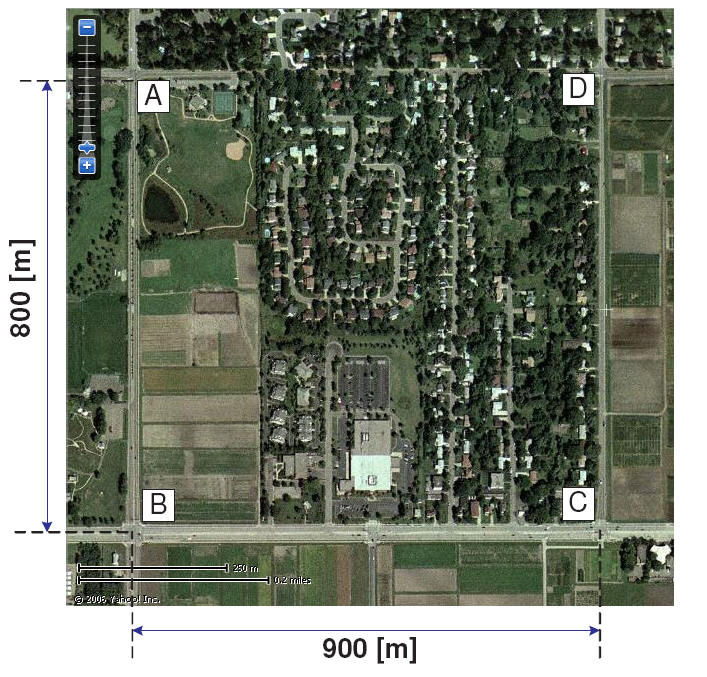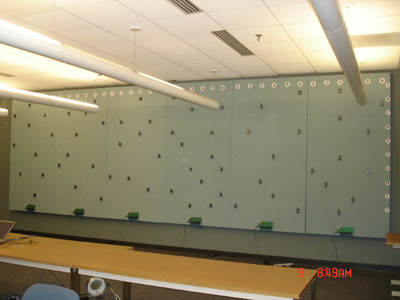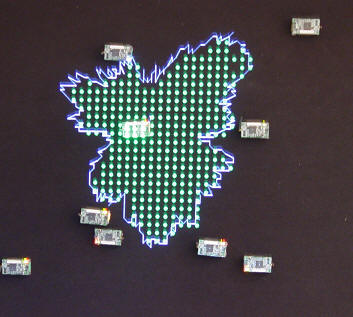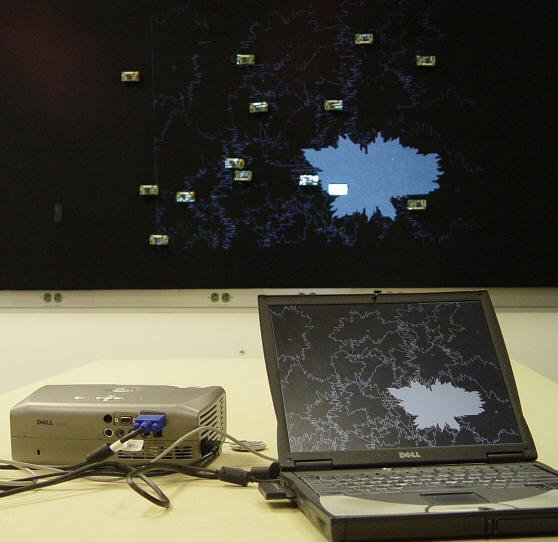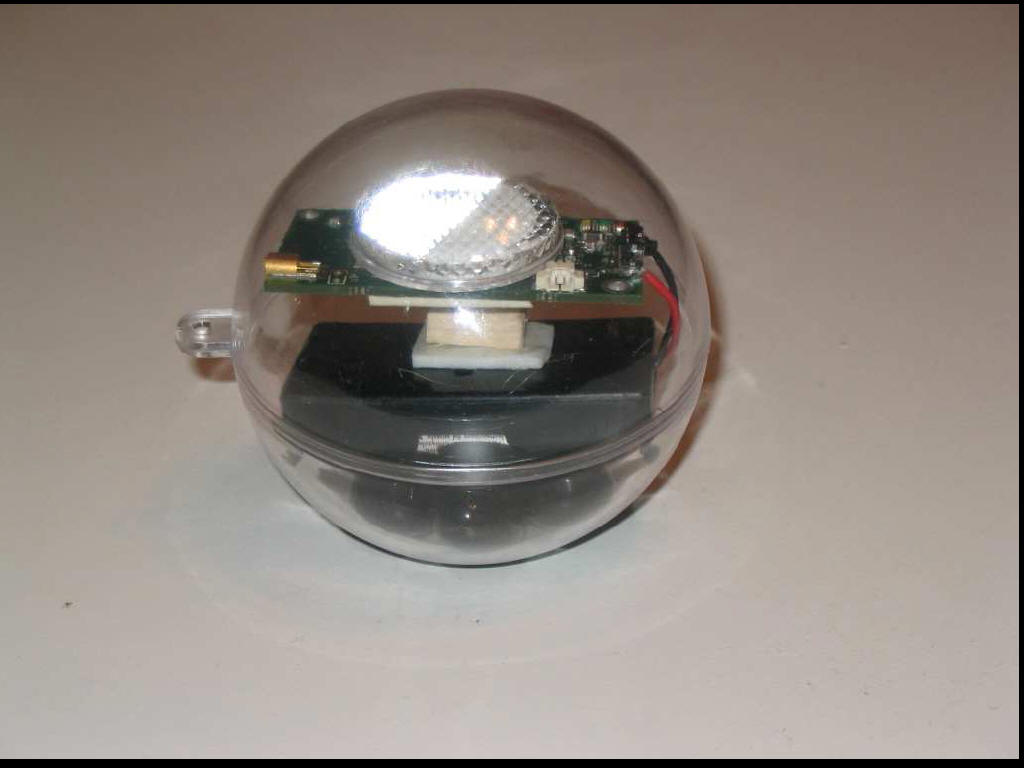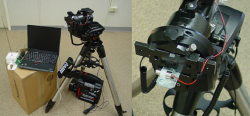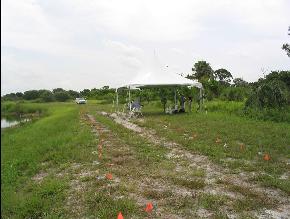 |
|
Current Research Directions
-
WIRELESS: Wireless Coexistence [Project Site]
-
WEARABLES: Posture/behavior estimation, social interaction monitoring [Project Site]
-
CPS: Large-Scale Intelligent Transportation Systems (road network efficiency and safety) [Project Site]
-
ENERGY: Rechargeable Sensor Systems/Battery Array Management/Safe charging
Current Ph.D. Students
|
CS. Fall 2010 CS, Fall 2011 CS, Fall 2012 |
CS, Fall 2014 CS, Fall 2014 CS, Fall 2015 |
Ph.D. Graduates
|
PhD, CS, Assistant Professor at Singapore University of Technology and
Design (now IBM Research) PhD, CS, Assistant Professor at University of Nebraska Lincoln (now TI) PhD, CS, Assistant Professor at SUNY Binghamton (now University of Maryland Baltimore County) PhD, CS, Assistant Professor at City University of Hong Kong PhD, CS, Assistant Professor at Sungkyunkwan University PhD, CS, Intel Security PhD. ECE, Arista Networks PhD, ECE, Assistant Professor at University of Wisconsin - Stout PhD, ECE, Lemko Corporation |
Master Graduates
|
Master, Oracle Master, Amazon Inc Master, LSI corporation |
Visiting Scholars/PostDocs
Welcome to apply if you are largely self-funded. Please email tianhe@cs.umn.edu
|
Associate Professor, Central South
University Visiting Ph.D. student, Nanjing University Visiting Ph.D. student, NUDT Assistant Professor, Umm Al Qura University Assistant Professor, China University of Mining and Technology Associate Professor, Sichuan University Assistant Professor, ISEE, Kyushu University Assistant Professor, Northeastern University Associate Professor, Dalian University of Technology Associate Professor, Hangzhou Dianzi University Research Scientist, UESTC |
Selected Research Projects
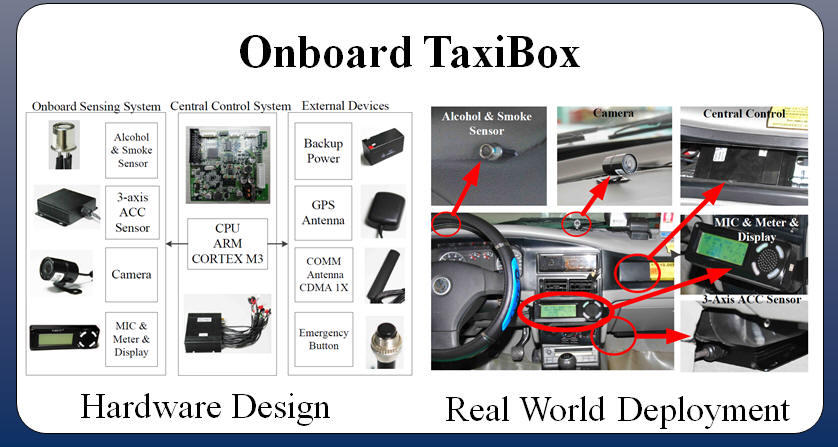 |
TaxiBox consists of three main parts: central control system, onboard sensing system, and external devices. With various onboard sensors, a dispatching center is capable of monitoring the comprehensive physical status of a taxicab on streets. Various external devices can be integrated into our Taxi- Box. Some external devices in the current TaxiBox design include (i) a display and a speaker integrated to the display; (ii) a traditional fare meter for fare calculation and receipt printing; (iii) backup power for a situation in which the main power is not available; (iv) an emergency button; (v) a GPS module with a separate GPS antenna; and (vi) a CDMA 1X communication module with a separate antenna. This design and usage of this device has been reported in MobiCom 13, BIGDATA 203, SENSYS 2012 and SenSys 2013 [PDF ]. [Data Source] | |
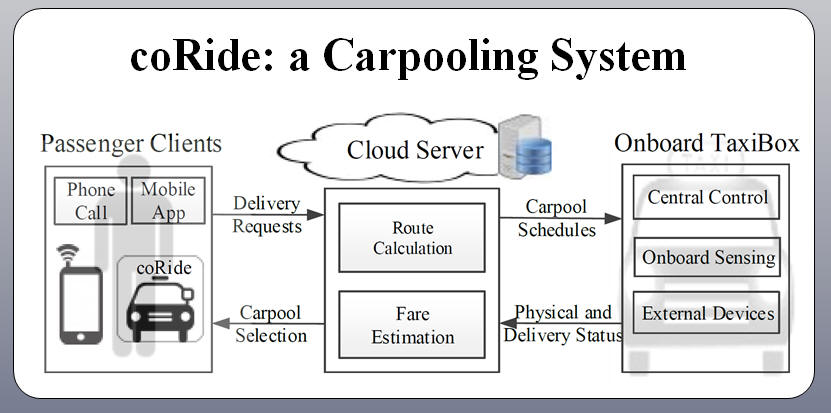 |
Carpooling has long held the promise of reducing gas consumption by decreasing mileage to deliver co-riders. In this work, we present coRide in a large-scale taxicab network intended to reduce total mileage for less gas consumption. Our coRide system consists of three components, a dispatching cloud server, passenger clients, and an onboard customized TaxiBox device. In the coRide design, in response to the delivery requests of passengers, dispatching cloud servers calculate cost-efficient carpool routes (Ratio-2 optimal) for taxicab drivers and thus lower fares for the individual passengers. We evaluate coRide with a real world dataset of more than 14,000 taxi- cabs, and the results show that compared with the ground truth, our service can reduce 33% of total mileage; This system has been reported in SenSys 2013 [PDF ]. | |
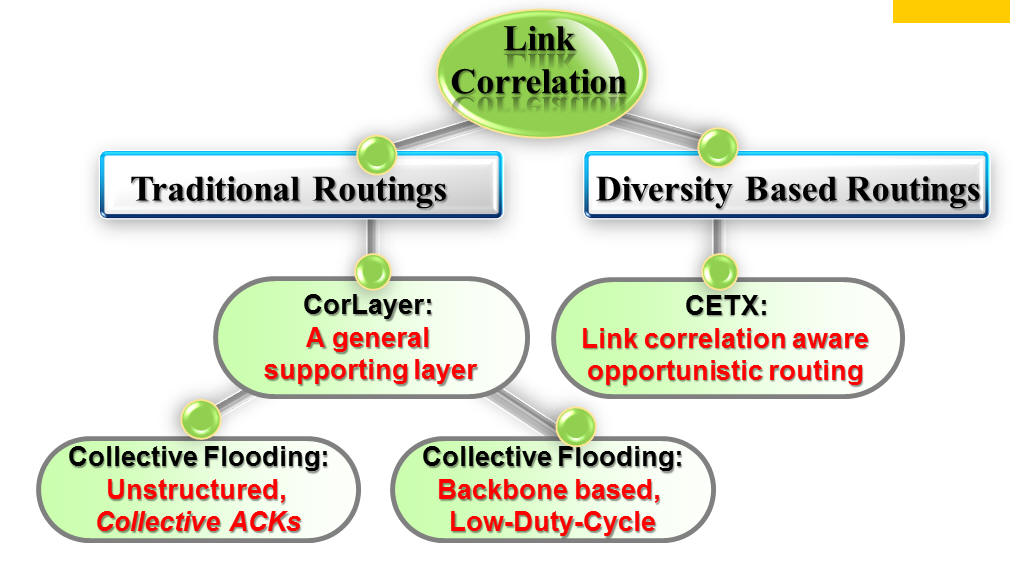 |
To understand how environments impact wireless communication, researchers have studied extensively on the packet reception quality of individual wireless links in real-world environments. In contrast, little research has been done to investigate the reception correlation of wireless links and its related impact on network-layer performance, despite the fact that wireless communication essentially occurs in a broadcast medium with concurrent receptions. To address this gap, we propose an in-depth systematic study to cover a large design space from empirical measurement, modeling, and impact analysis to design and implementation of protocols that exploit spatiotemporal patterns of link pathcorrelation. The inital work has been reported in NSDI 2010 and MobiCom 2013 | |
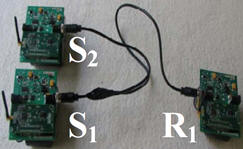 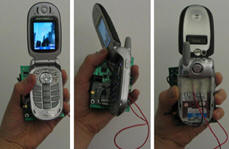 |
eShare supports the concept of energy sharing among multiple devices by providing designs for energy routers (i.e., energy storage and routing devices) and related energy access and network protocols. In a nutshell, energy routers exchange energy sharing control information using their data network while sharing energy freely among connected devices using their energy network. We extensively evaluate our system under six real-world settings and the result has been reported in ACM SenSys 2010 [PDF]. | |
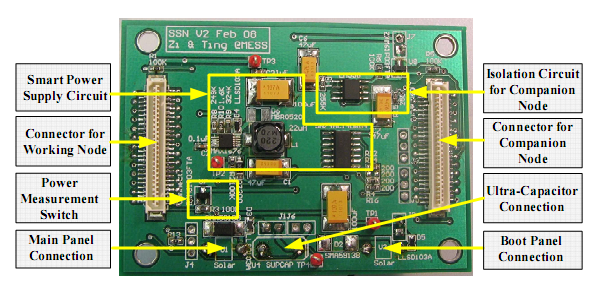 |
TwinStar is built upon recent breakthrough in energy storage using ultra-capacitors. We uniquely feature a battery-less node design with a combination of solar cells and ultra-capacitors, which can store tens of thousands more energy than traditional capacitors. One of main challenging problems is to efficiently utilize the energy in the presence of large leakage current exhibited in such capacitors. Our objective is to guarantee aliveness of sensor nodes between two consecutive recharging cycles using leakage-aware feedback control. With SSN nodes available, many long-term sensor network applications, such as bridge monitoring, can be practically supported. This system has been reported in MobiSys 2009. [PDF] | |
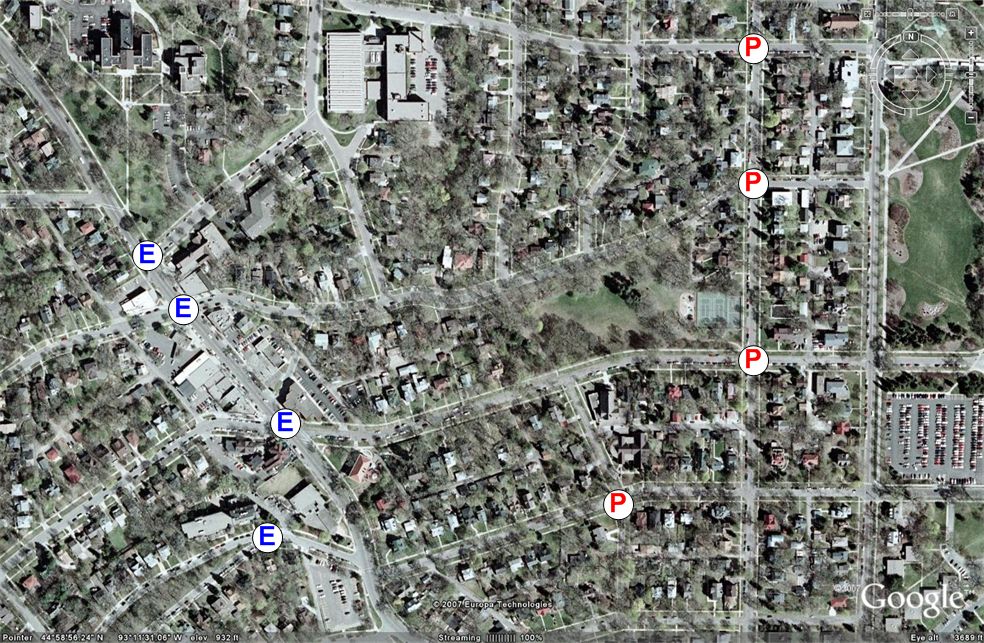 |
In road networks, wireless sensors are deployed along the road ways for surveillance. This project proposes a virtual scanning algorithm, called VISA. We consider the surveillance scenario that entrance points on road map are specified as possible vehicle entrances and protection points are specified as important points before which vehicles should be detected. We guarantee the detection of moving vehicles entering entrance points of label E on the road network before they reach protection points of label P. Our objective is to maximize the lifetime of the sensor network deployed on the road network, satisfying such a detection guarantee. We construct a virtual graph composed of vertices and edges where the vertices are road intersections, protection points and entrance points and the edges are distances along with the number of sensors deployed on the road segments. This virtual graph is used to determine each sensor's duty cycle consisting of the working schedule and sleeping schedule. We evaluate our design outdoor in Minnesota roadways and show the detection guarantee despite of some sensing holes due to the absence of sensors. This system has been reported in Infocom 2009. [PDF] | |
|
|
In
road networks, sensor nodes are deployed sparsely (hundreds of meters
apart) to save costs. This makes the existing localization solutions
based on the ranging ineffective. To address this issue, we introduce an
Autonomous Passive Localization (APL) scheme. Our work is inspired by
the fact that vehicles move along routes with a known map. Using
vehicle-detection timestamps, we can obtain distance estimates between
any pair of sensors on roadways to construct a virtual graph composed of
sensor identifications (i.e., vertices) and distance estimates (i.e.,
edges). The virtual graph is then matched with the topology of road map,
in order to identify where sensors are located in roadways. We evaluate
our design in local roadways and simulated environments, where we found
no location matching error, even with a maximum sensor time
synchronization error of 0.3sec and the vehicle speed deviation of
10km/h.. This system has been reported in Infocom 2008. [PDF] |
|
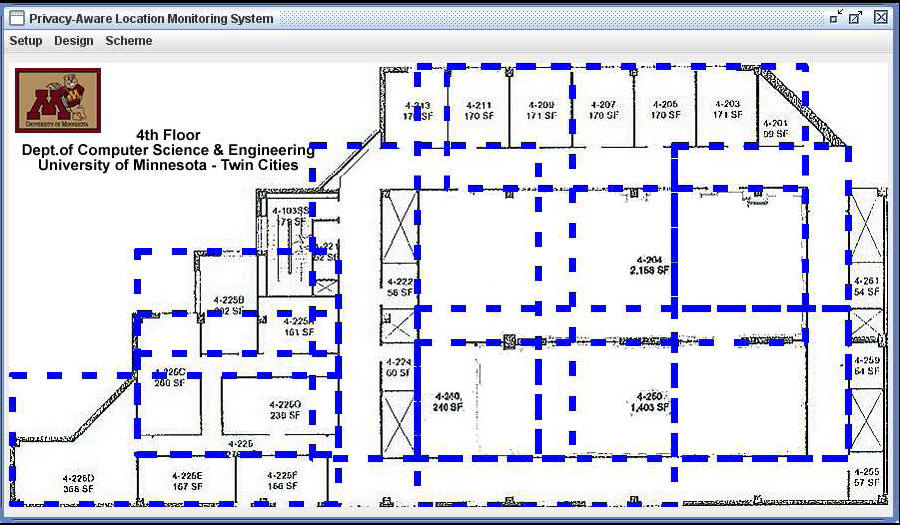 |
TinyCasper proposes two in-network distributed algorithms, namely Minimum Resource and Optimal Area that aim to preserve personal privacy in such areas while maintaining the monitoring functionality. Both algorithms reply on the well established privacy concept of k-anonymity; Although both proposed algorithms provide same privacy guarantees, the Minimum Resource aims to do so with minimum possible number of exchanged messages between sensor nodes while the Optimal Area algorithm aims to maintain the highest quality of monitoring functionality. Furthermore, to accommodate the system users mobility, we propose an incremental maintenance scheme for both algorithms that aims to avoid redundant reevaluation of privacy guarantees. The proposed system is evaluated with a network of 39 MICAz motes on a physical test-bed, and an extensive simulation of 1,000 sensor nodes. [Demo Video] | |
|
Mirage is a large indoor sensor network test-bed, supporting up to 360 nodes. The whole test-bed is composed of six 4 feet by 8 feet boards. Each board in the system can be used as an individual sub-system, because each board is designed to be separately powered, separately controlled and separately metered. Each individual board can support up to 60 nodes, therefore, the whole system can support up to 360 nodes working simultaneously. In the first phase of construction, three high-end HIT HITCPX1250 projectors are used to generate event (it is capable to create mirage ). In the second phase of construction, motorize objects are introduced to create another sets of mobile targets. The ultimate goal of this testbed is to allow researchers to conduct all kinds of system research locally and remotely with realistic sensing modality as inputs. The first phase of construction is finished during 2007. In the second phase, mobility support will be added. |
|
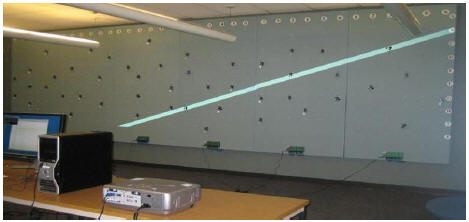 |
Multi-Sequence
Positioning (MSP) is designed and implemented for sensor node
localization in outdoor environments. The novel idea behind MSP is to
reconstruct and estimate two-dimensional (or 3D) location information
for each sensor node by processing multiple easy-to-get one-dimensional
node sequences obtained through a loosely guided event distribution. We
have realized the MSP idea through two physical systems (indoor and
outdoor version) with totally over 60 MICAZ motes. This evaluation
demonstrates that MSP can achieve sub-feet-level accuracy, requiring
neither additional hardware on sensor nodes nor precise event
distribution. It also provides a nice tradeoff between physical costs
(anchors) with soft cost (events) while maintaining localization
accuracy.[Demo Video] This system has been reported in SenSys 2007. [PDF ] |
|
|
|
Despite the well-known fact that in reality sensing patterns are highly irregular, researchers continue to develop protocols with simplifying assumptions of circular 0/1 sensing models. In this project, we design and implement two Sensing Area Modeling (SAM) techniques useful in the real world. P-SAM provides accurate sensing area models for individual nodes using controlled or monitored events, while V-SAM provides continuous sensing similarity models using natural events in an environment. Evaluation under real-world settings reveal several serious issues concerning circular models, and demonstrate significant improvements in several applications when SAM is used. This system has been reported in SenSys 2007. [PDF ] |
|
|
|
uSense defines
a Unified Sensing Coverage Architecture, which features three novel
ideas: Asymmetric Architecture, Generic Switching and Global Scheduling.
uSense provides sensing coverage through a creative separation of
scheduling from switching. We design and implement sophisticated
scheduling algorithms externally and represent such intelligence with a
lightweight generic switching algorithm running at resource-constrained
sensor nodes. As an instance of these scheduling algorithms, we propose
a novel two-level scheduling algorithm, called uScan. We evaluate our
architecture with a network of 30 MicaZ motes, an extensive simulation
with 10,000 nodes. The results indicate that uSense is a promising
architecture to support flexible and efficient coverage in sensor
networks. This system has been reported in ICDCS 2007 [PDF ] and MobiCom SRC competition 2006 |
|
|
|
In this project, we design and test a methodology for navigation of mobile wireless sensor networks and fast target acquisition without a map, called GraDrive. Our approach integrates per-node prediction with global collaborative prediction to estimate the position of a stationary target and to direct mobile nodes towards the target along the shortest path. We demonstrate that a high accuracy in localization can be achieved much faster than existing navigation models without any assistance from stationary sensor networks. This system won the best paper award in the 2nd International Conference on Mobile Ad-hoc and Sensor Networks (MSN 2006) [PDF ] |
|
|
|
In this project we design and implement a framework, called StarDust, for wireless sensor network localization based on passive optical components. In the StarDust framework, sensor nodes are equipped with optical retro-reflectors. An aerial device projects light towards the deployed sensor network, and records an image of the reflected light. An image processing algorithm is developed for obtaining the locations of sensor nodes. For matching a node ID to a location we propose a constraint-based label relaxation algorithm. We propose and develop localization techniques based on four types of constraints: node color, neighbor information, deployment time for a node and deployment location for a node. This system has been reported in SenSys06 [PDF ] |
|
|
|
Spotlight
uses the spatio-temporal properties of well controlled events in the
network (e.g., light), to obtain the locations of sensor nodes. We
demonstrate that a high accuracy in localization can be achieved without
the aid of expensive hardware on the sensor nodes, as required by other
localization systems. Through performance evaluations of a real system
deployed outdoors, we obtain a 20cm localization error. A sensor
network, with any number of nodes, deployed in a 2500m2 area, can be
localized in under 10 minutes, using a device that costs less than
$1000. To the best of our knowledge, this is the first report of a
sub-meter localization error, obtained in an outdoor environment,
without equipping the wireless sensor nodes with specialized ranging
hardware.
This system has been reported in SenSys05 [PDF ][Demo Video] |
|
|
|
Vigilnet is one
of the major efforts in the sensor network community to build an
integrated sensor network system for surveillance missions. The focus of
this effort is to acquire and verify information about capabilities and
positions of targets. Such missions often involve a high element of risk
for human personnel and require a high degree of stealthiness. Hence,
the ability to deploy unmanned surveillance missions, by using wireless
sensor networks, is of great practical importance. In this work, we
design and implement a complete running system, called VigilNet, for
energy-efficient surveillance. It currently consists about 40,000 lines
of NesC and Java code, running on XSM, Mica2 and Mica2dot platforms. The
complete system is designed to scale to at least 1000 XSM motes and
cover minimal 100x1000 square meters to ensure operational
applicability. We evaluate middleware and system performance extensively
on a network of 203 MICA2 motes. Various aspects of the VigilNet system have been reported in MobiSys04 [PDF], SenSys05 [PDF] , Infocom05 [PDF], RTAS06 and TECS [PDF] |

